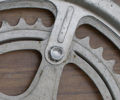From Bike Collectives Wiki
- Sorting cranks is mostly a visual process - all you need to know to sort cranks correctly is in which ways they look different.
This is a cottered crank which uses a cotter pin. These were on old bikes, and at the co-op are mostly found on cheaper old bikes. If you are sorting a cottered crank, it has come off of a bike. Cottered cranks are almost never put back onto bikes. Notice the round hole at the end of the arm which is in the middle of the geared ring.
This is a closeup of the end of a cottered crank arm. You can see the hole that the cotter goes through on the side (in shadow).
This is a cheap cotterless road crank. Notice that the hole in the middle of the chainring is square instead of circular. Cottered cranks attach differently to the bottom bracket.
This is a closeup of the above crank. Notice how the crank is bolted together using ordinary hex nuts. If the crank were good, it would be bolted together using allen bolts.
This is a cheap mountain crank. The chainrings are steel and they are riveted together. They look sort of like they might be bolted using allen bolts, but an inspection of the back of the crank lets you know that they are not.
The back of that mountain crank. It is obvious that the rings are riveted on.
A left crank. There is nothing special about it, but this is what a left crank looks like.
This is a one piece crank with no chainrings. These are also known as American cranks. Notice how the piece includes both left and right crankarms and the bottom bracket spindle.
Here is an American BMX crank with a chainwheel on it.
Here is a typical American crank you might see at the co-op. It is from a cheap old bike and has the steel rings and chainguard still attached.








